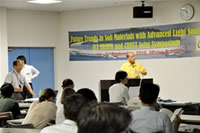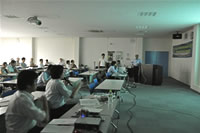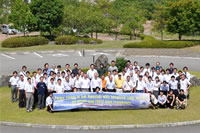


The ERATO Takahara Soft Interface Project (hereinafter, "Takahara ERATO"), together with CREST research area of the "Development of the Foundation for Nano-Interface Technology" involving the research project of Manipulation of Nano Interface of Drug-Delivery System and Its Application to Vaccine for Bird Flu (Research Director: Kazuo Sakurai) (hereinafter, "Sakurai CREST") held an international symposium related to the use of advanced light sources with soft materials and interfaces.
Takahara ERATO's "soft interface design inspired by natural systems" is advancing research on high performance soft interfaces inspired by the natural world. Sakurai CREST seeks to propose new concepts in drug delivery system nanoparticle designs through analysis of nano-interface structures within DDS's using synchrotron radiation. Because methods such as neutron scattering and synchrotron x-ray scattering are extremely important in both projects, the above-mentioned international symposium was held at SPring-8 (the world's largest synchrotron facility) in Harima, Hyogo Prefecture, from September 1-3. Eight invited speakers from overseas and 11 from Japan held lively discussions over a substantial 2-day period.
The content of the lectures fell into four general categories. The first category included experiments using synchrotron radiation and neutrons to clarify at the molecular level specific interfaces formed by soft materials, on which Dr. Tadanori Koga (Stony Brook Univ.), Dr. Moonhor Ree (POSTECH), Dr. Naoya Torikai (Mie Univ.), and Dr. Sushil K. Satija (NIST) all spoke. The discussion relating to Dr. Koga's experiments on micro-viscoelasticity and molecular structure of surfaces was a productive encounter. In addition, Dr. Ree's pioneering research in this field left a wide-ranging deep impression. His group in Korea's work on surface chemistry using x-rays will surely continue to lead the pack in the future.
The second area was research on the structure of self-assembled super-molecular objects and their formation mechanisms. This work relates to basic DDS research, along with experiments to better understand vital reactions through artificial reproduction of in vivo DNA folding structures, etc. Presentations were made by researchers who first opened up this field: Dr. Cyrus Safinya (Univ. of California, Santa Barbara), Dr. Hsin Lung Chen (Tsinghua Univ.), Dr. Marcin Sikorski (APS), and Dr. Hideki Seto (KENS). Through Dr. Safinya's lecture, everyone came to understand that we have now progressed to a point at which there is no boundary between biophysical and super-molecular chemistry.
The third area was research demonstrating that we can resolve previously incomprehensible problems related to generic polymeric materials through use of advanced light sources. Dr. Takashi Sakurai (Sumitomo Chemical Co.) and Dr. Alexander Norman (Exxon Mobil Research and Engineering Co.) discussed this from the standpoint of industry. In addition, Dr. Yuya Shinohara (Univ. of Tokyo), Dr. Toshiji Kanaya (Kyoto Univ.), Dr. Mikihito Takenaka (Kyoto Univ.), and Dr. Shinichi Sakurai (Kyoto Inst. Tech.) offered insights from the standpoint of high polymer chemistry. Everyone got the impression that work such as Dr. Shinohara's x-ray photon correlation methods and Dr. Takenaka's visualization using electron micrographs are areas that will see a lot of growth in the future.
The fourth area included solution scattering of proteins and lipids, as well as structural biology. Dr. Hideki Seto (KENS), Dr. Naoto Yagi (JASRI), Dr. Satoshi Koizumi (JAEA), Dr. Mamoru Sato (Yokohama City Univ.), Dr. Mitsuhiro Hirai (Gunma Univ.) and Dr. Michael Sztucki (ESRF) all made presentations. In this area, it was felt that we can look forward to seeing how contrast modulation methods using atomic abnormal absorption edges will develop in the future.
Synchrotron radiation facilities are under construction in various parts of the world, and their measuring technology will continue to become increasingly indispensible to future research on organic and biomaterials. In fact, SPring-8 has a beam line dedicated to soft materials currently under construction, which will have the world's strongest light for cooperative use by industry and academia. In addition, it is thought that these days, as development of XFEL with SASE as a next generation light source continues, so will the advancement of theories related to organic materials and the use of femtosecond synchrotron radiation, coherent x-rays, etc. In order to maintain a level of synchrotron based research into organic and biomaterials that leads the rest of the world, how can we grapple with the most advanced research problems, over and above upgrading facilities? In addition, how can the fruits of that research be applied as industrial technologies?
Those in the organic and biomaterials, low-angle scattering research community have a history of developing their work independently, leading to the same phenomena being described in different ways, resulting in a situation where collaboration and cooperation within the field is not exactly active. In addition, where applied use in various industries is concerned, sometimes conflicts arise over product or trade secrets, resulting in a paucity of publicly published papers.
Set against this background, this symposium invited active, world-class researchers in biophysics, super-molecular assembly, development of next generation synchrotron equipment, as well as liquid surfaces, super-molecules, solid polymers, etc., in order to have interdisciplinary exchanges. With this, we think we were able to contribute to setting a course for synchrotron research on organic and biomaterials for the coming decade.
JST, an integrated organization of science and technology in Japan, establishes an infrastructure for the entire process from the creation of knowledge to the return to the society. For more information, visit http://www.jst.go.jp/EN/